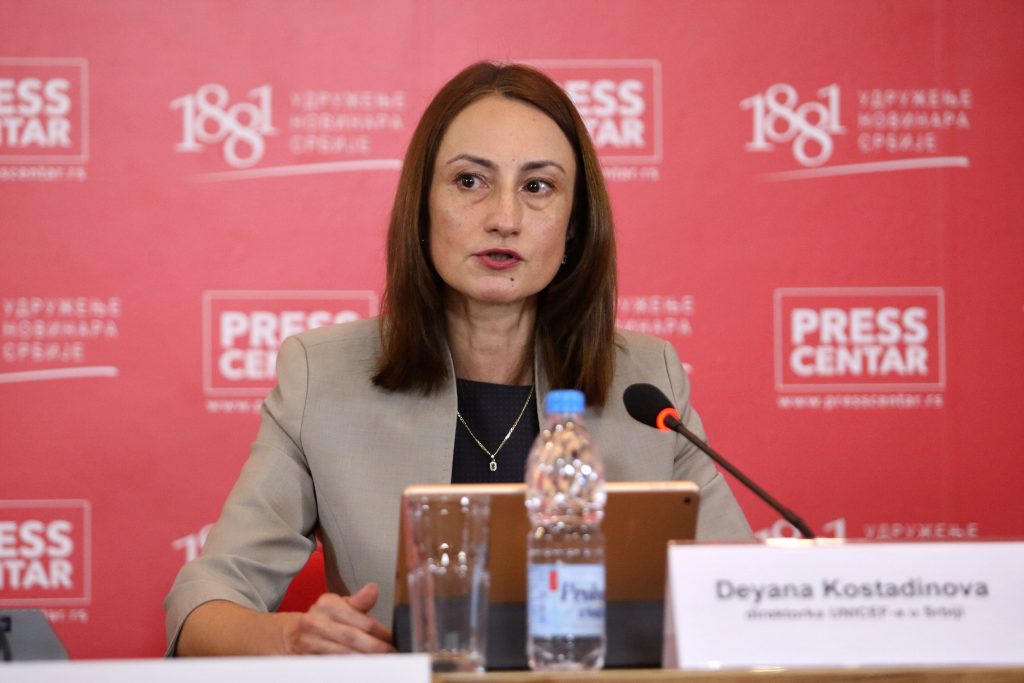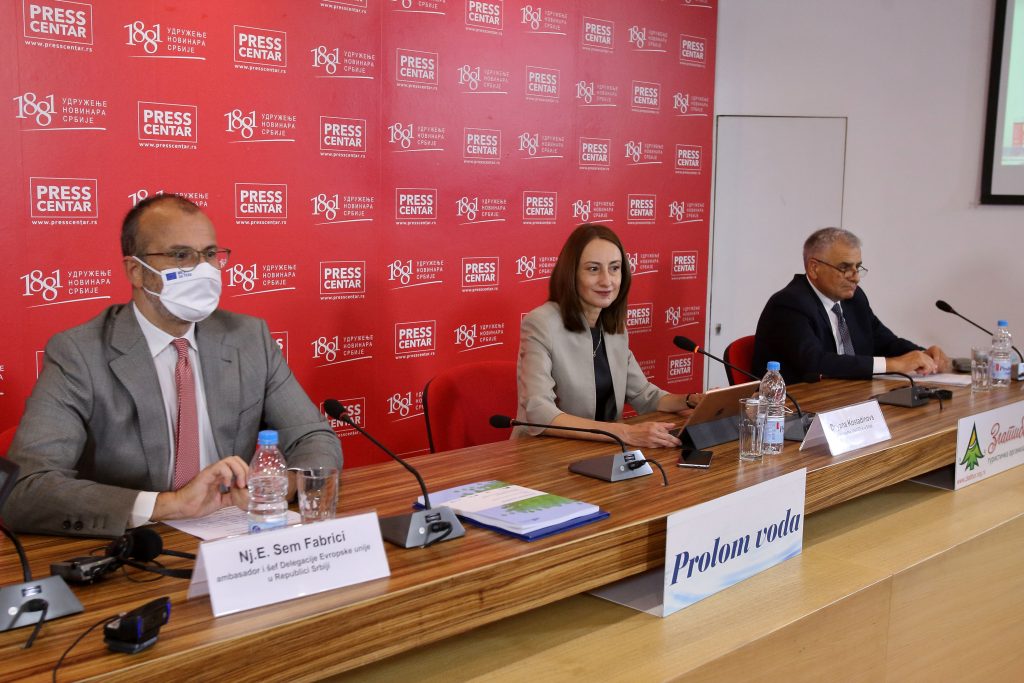Children from the poorest and most excluded families are lagging behind other children in health, early learning and access to digital content
New data on the situation of women and children in Serbia show progress in key areas, including breastfeeding and preschool attendance, but also stagnation in the areas of child marriage and violent disciplining of children.
The data, released today by the Statistical Office of the Republic of Serbia, UNICEF, the United Nations Population Fund, (UNFPA) and the Delegation of the European Union to the Republic of Serbia, comes from the 2019 Multiple Indicator Cluster Surveys (MICS 6), the most comprehensive single source of data on the state of women and children in Serbia.
“Serbia has come a long way in addressing inequalities. The majority of children see their rights fulfilled. Reaching the most vulnerable and excluded children is often the most challenging part of the journey, but also the most critical one. This is why the MICS survey is so useful – it helps everyone track progress and identify trends – both positive and negative, in 5-year intervals. The government, businesses, and civil society now have a clear picture of where targeted action is needed to build on past successes and increase investments to reduce disparities,” stated Ms. Deyana Kostadinova, UNICEF Representative in Serbia.

The findings clearly show that inclusive action targeting the most excluded children and families is having a positive impact. Now is the time to build on past achievements and accelerate progress in the Decade of Action towards 2030 and the Sustainable Development Goals so to leave no child behind and allow every child to thrive.
“This survey gives useful insight on how Roma population lives in comparison with the rest of Serbia, providing an evidence-based approach to implement better policies. In particular, it will help Serbian policy makers with solid and qualitative data to indicate priorities and make decisions. The indicators used and results obtained with this research are similar to the ones used by the EU to monitor progress and direct our support for Serbia’s accession path. Accurate data, collected and analysed in line with the EU and worldwide accepted methodologies will enable comparing key areas, including woman and child protection, education, employment, housing, and gender equality, and thus allocating the necessary support in the most effective ways. The European Union is a partner of the Serbian Government in such process. With a current granting of EUR 30 million for the implementation of Roma inclusion projects, the EU is Serbia’s main donor also in the area of Roma development,” said Ambassador Sem Fabrizi, Head of the Delegation of the European Union to the Republic of Serbia.

The survey results are launched at an opportune time as the global COVID-19 pandemic has affected Serbian children, young people, and families in different ways. The data, collected prior to the pandemic, will help the Government and other stakeholders to effectively monitor the success of the recovery process in the coming years.
“There are good indicators and data in many areas, such as skilled attendance at birth which is important for all women in Serbia. However, we can see that the situation remains largely unchanged compared to 2014 in most domains related to sexual and reproductive health. Use of modern contraception methods remains low and persistent inequalities for women in rural as well as Roma settlements are still there. We need to do more to dismantle barriers, stigma and taboos around women’s health,” said John Kennedy Mosoti, UNFPA Country Director for Serbia.
“In the period from September to December 2019, the Statistical Office of the Republic of Serbia conducted MICS 6, the most comprehensive source of data on the position of women and children in Serbia, as two surveys – one survey was based on the sample of 8,100 households selected for the national representative sample, and another was based on the sample of 1,934 households in Roma settlements,” said Mr. Miladin Kovačević, Director of the Statistical Office of the Republic of Serbia.
Selected Key Findings:
Significant progress has been made in increasing immunization rates, net attendance in education, and decreasing infant and under-five mortality among children in Roma settlements. Exclusive breastfeeding rates have increased among the general population, and pre-school attendance has increased overall with particular progress among children living in rural areas. Yet, child marriage rates have stagnated, violent disciplining practices remain unacceptably high, and too many girls in Roma settlements continue to get married before age 18.
Key successes in narrowing disparity gaps
There has been some progress for children in Roma settlements.
Child mortality: Infant mortality of Roma children has reduced to 8 per 1,000 live births, while under-five mortality is about 9 per 1,000 live births, down from 12.8 and 14.4 in 2014, respectively. They are still significantly higher than in the general population.
Immunisation: Full immunisation coverage of children in Roma settlements (24-35 months) is up from 44% in 2014 to 63% in 2019. Among children in the general population it remains almost the same as in 2014 – 80%. Timely immunisation of children (24-35 months) is 69% in the general population, and as low as 35% among children in Roma settlements.
Education: Net attendance in secondary education has almost doubled for Roma girls (from 15% in 2014 to 27% in 2019). It is still far from the national average, which is 3 times higher in net attendance in secondary education.
Key achievements in ensuring a better future for children
Several areas of child well-being have seen significant progress for children in Serbia.
Breastfeeding: In 2019, 24% of children aged 0-5 months were exclusively breastfed, compared to 13% in 2014. In Roma settlements, only 8% are exclusively breastfed.
Preschool education: Attendance rates in early childhood education (36-59 months) in the overall population in Serbia have increased from 50% in 2014 to 61% in 2019. There is particular progress in the rate of attendance of children living in rural areas (from 27% in 2014 to 46% in 2019).
Key areas of stagnation
There are also areas that give rise to concern.
Child marriage: Rates of child marriage in the population of girls and young women from Roma settlements remain exceptionally high. More than half (56%) of women aged 20-24 years were married before age 18 and 16% married before age 15.
Violent disciplining of children 1-14 years: 45% of children aged 1 to 14 years of age experience violent disciplining at home, and the percentage in Roma settlements is even higher (67%).
Children from households living in poverty remain worse off: Children living in the poorest households have less books available at home compared to their peers. Only 48% of children living in the poorest quintile have 3 or more books at home, compared to 90% of children from the wealthiest quintile.
Only one in 5 of the poorest households has a computer or tablet at home, compared to 97% of households from the richest quintile.
New insights – women in Serbia
MICS data offer additional insights into the position of women.
Fertility: Fertility rates are highest in the 30-34-year age group in the overall population of women in Serbia, and in the 20-24-year age group of women in Roma settlements. The total fertility rate among Roma women aged 15-49 years is higher than in the general population.
Discrimination and harassment: 7% of women aged 15-49 years in Serbia and 13% of women of the same age in Roma settlements in Serbia were victims of discrimination and harassment in the last 12 months.
Crime reporting: 40% of women aged 15-49 years in Serbia and 67% of women the same age from Roma settlements in Serbia stated that the last incident of physical violence of robbery and/or assault in the last year was reported to the police.
Emerging agenda
Functioning and Mental Health of Adolescents: Adolescents aged 15-17 years are slightly more likely to have functional difficulty in the affect domain (anxiety and depression) compared to adolescents from lower age groups.
Reliance on clean fuels and technologies: The percentage of households that use clean fuels and technologies for cooking, heating and lighting is 52% at national level and 12% in Roma settlements.